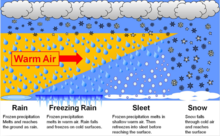An ice storm is a type of winter storm characterized by freezing rain, also known as a glaze event or, in some parts of the United States, as a silver thaw. The U.S. National Weather Service defines an ice storm as a storm which results in the accumulation of at least 0.25-inch (6.4 mm) of ice on exposed surfaces. They are generally not violent storms but instead are commonly perceived as gentle rains occurring at temperatures just below freezing.

Heavy accumulations of ice can bring down trees and topple utility poles and communication towers. Ice can disrupt communications and power for days while utility companies repair extensive damage. Even small accumulations of ice can be extremely dangerous to motorists and pedestrians. Bridges and overpasses are particularly dangerous because they freeze before other surfaces.
Black Ice: Black ice is a deadly driving hazard defined as patchy ice on roadways or other transportation surfaces that cannot easily be seen. It is often clear (not white) with the black road surface visible underneath. It is most prevalent during the early morning hours, especially after snow melt on the roadways has a chance to refreeze over night when the temperature drops below freezing. Black ice can also form when roadways are slick from rain and temperatures drop below freezing overnight.
Ice Jams: Long cold spells can cause rivers and lakes to freeze. A rise in the water level or a thaw breaks the ice into large chunks which become jammed at manmade and natural obstructions. Ice jams can act as a dam, resulting in severe flooding.
Ice Recreation: Ice on lakes and streams can be deadly. Before fishing, skiing, snowmobiling or engaging in any other activities on ice, check with local officials, such as your State Department of Natural Resources, who monitor the body of water. If you see any of the following conditions, do NOT go out on the ice:
- Cracks, holes or breaks in the ice
- Flowing water around the edges, just below the surface, or over the top of the ice
- Ice that appears to have thawed and refrozen
If you decide to venture out on the ice, remember the following guidelines:
- Stay off the ice if it is less than 2 inches thick!
- For ice fishing, ice skating and walking, you need 4 inches or more of ice.
- For snowmobiles and ATVs, you need at least 5 inches.
- To drive a car or small pickup on ice you need at least 8 to 12 inches of ice.
- For medium-sized trucks, there must be at least 12 to 15 inches.
White or “snow” ice is only about half as strong as new, clear ice. Double these thickness guidelines when traveling on white ice. For more information on ice thickness and safety.
Frost: Frost describes the formation of thin ice crystals on the ground or other surfaces in the form of scales, needles, feathers, or fans. Frost develops under conditions similar to dew, except the temperatures of the Earth’s surface and earthbound objects fall below 32°F. As with the term “freeze,” this condition is primarily significant during the growing season. If a frost period is sufficiently severe to end the growing season or delay its beginning, it is commonly referred to as a “killing frost.” Because frost is primarily an event that occurs as the result of radiational cooling, it frequently occurs with a thermometer level temperature in the mid-30s.

